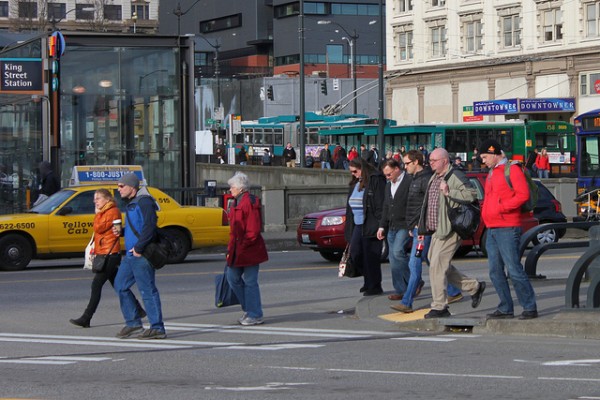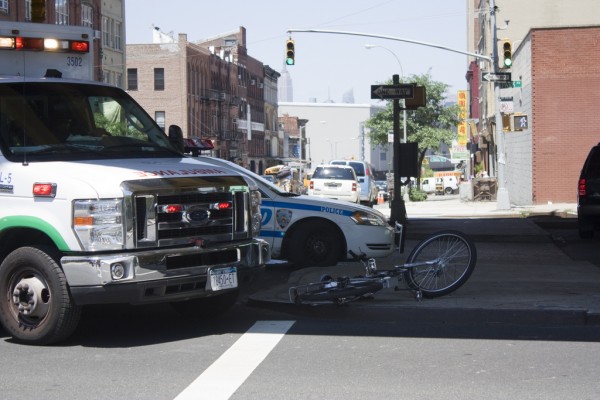Newton’s Laws of Motion
F=Force, M=Mass, A=Acceleration
First Law: A body will remain at rest or continue to move in a straight line at a constant speed unless acted upon by an unbalanced force, F.
Second Law: If an unbalanced force, F, acts upon a body, its center of mass will accelerate in the direction of the force. The acceleration, a, is proportional to the force, F, and the constant of proportionality, m, is called the mass of the body. F=MA
Third Law: For every force acting on a body, there is an equal and opposite force acting on something else. (For every action there is an equal and opposite reaction)
Speed Change
The best single measure of the severity of a collision is the speed change that the vehicle undergoes during the brief time interval of the collision. The speed change is the magnitude of the difference between the pre-impact and post-impact velocities of the vehicle. It occurs in a split second. In fact, a typical car collision is over in 0.12 of a second. This means that an occupant’s body and head could be jerked from 0 to 10 mph in a spilt second. Breaking it down this way makes it clear why a low speed collision can cause moderate to severe neck and back injury and pain.
The concept of the collision speed change is especially important in low speed collisions because the amount that a vehicle rebounds in a collision that results in little or no damage is significant.
In most cases, the only thing that matters to the occupant is the speed difference between his or her body and the vehicle interior.
Types of Impacts in Auto Accidents
Rear impacts
Frontal impacts
Lateral Impacts
Sideswipes
Within each type of impact the accident reconstruction expert will try to determine:
- Vehicle Dynamics (the motion of bodies under the action of forces.)
- Occupant Kinematics (the motion of objects without reference to the forces that cause the motion.)
Vehicle Dynamics & Occupant Kinematics
Questions to occupants & witnesses to determine Vehicle Dynamics & Occupant Kinematics:
- Vehicle Dynamics:
- Was your vehicle at rest?
- If not, what was its speed?
- Did your vehicle move as a result of the impact?
- How far?
- Were you behind another vehicle?
- How far?
- Did you hit the vehicle in front?
- Was the vehicle in gear?
- Which gear?
- Were the brakes applied?
- How hard?
- What was the speed of the other vehicle when it struck your vehicle?
- Occupant Kinematics:
- What was your height and weight at the time of the collision?
- Where was the seat positioned?
- How was the seat back adjusted?
- Was the seat belt used?
- What type of seat belt was used and how was it adjusted?
- Where was the head restraint adjusted?
- What was your posture in the seat?
- Where were you looking?
- Did you know the impact was coming?
- Describe what happened to your body at impact.
- Did any portion of your body contact the vehicle interior?
The exact questions will vary from case to case, but at the end, there should be a complete description of the motion of the vehicle and occupants during the collision.
Rear Impacts
The risk of injury in any particular incident will be dependent on many factors including:
- Collision speed change,
- Vehicle structural characteristics,
- Seat and head restraint dynamic characteristics,
- Position of head restraints,
- Use of seat belts,
- Occupant age,
- Occupant sex,
- Occupant stature,
- Occupant posture,
- Predisposition to injury,
- Knowledge of impending impact.
NOTE- cost to repair the vehicle is not listed as a factor.
Injury Mechanisms in Rear Impacts
- Hyperextension/Hyper-flexion Injury-“Whiplash”
- Occupant’s body is accelerated forward,
- The head gets left behind because of its inertia,
- The neck extends backward beyond its normal limits,
- Forces developed in the neck accelerate the head forward,
- The neck overshoots its normal position, and
- The neck will then flex forward.
- Differential Rebound Injury
- Occupant’s torso rebounds forward from the seat prior to the head because of seat geometry and different seat and head restraint stiffness characteristics,
- The neck extends backwards even if there is a head restraint positioned behind the head.
- Tension/Compression Injury -“Ball and Chain”
Compressive and tensile (pressed & stretched) loading can develop in the cervical spine even though the overall motion of the head and neck are within normal limits, i.e. no hyperextension/hyper-flexion (whiplash).
- Spinal Canal Pressure Pulse Injury
Rapid head and neck motion, even if within normal limits, can cause pressure increases that may be damaging to nerves in the neck.
- Cervical Facet Joint Injury
The joints in the neck that allow flexibility are a common source of pain in rear impact claims.
Accident Reconstruction Testing & Research Has determined:
- Symptoms such as neck pain and headaches begin to be reported in low speed rear impacts at speed changes as low as 2½ mph.
- Research reveals a significant prevalence of neck injury in rear impacts with speed changes of 6 to 9 mph.
- Some vehicles can withstand a collision speed change of up to 8 or 9 mph and remain essentially undamaged. At this level of impact, the occupant’s acceleration is far from trivial and the collision is well above the threshold level at which symptoms such as neck pain and headache are reported.
- A “no-damage” collision can have a speed change of 1 mph or 8 mph. It is essential to know at which end of the range the speed change lies. Risk of injury may be virtually non-existent at the lower end, but at the upper end there is a strong potential for injury.
Vehicle repair costs are not a factor in determining the severity of an injury in a rear impact claim.
- To find out how MartinLaw, PLLC and attorney Chuck Martin will handle your car accident case please visit the car accident page.


